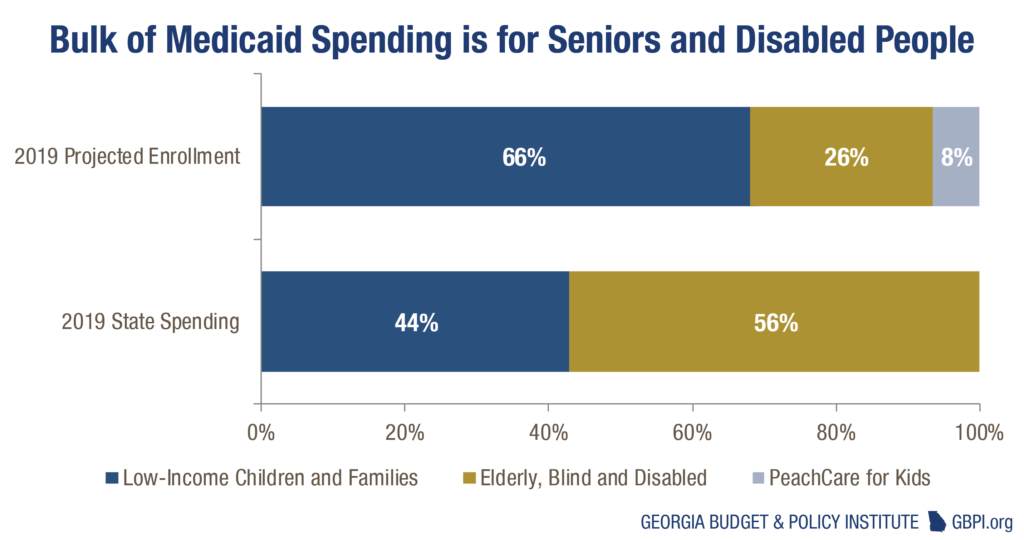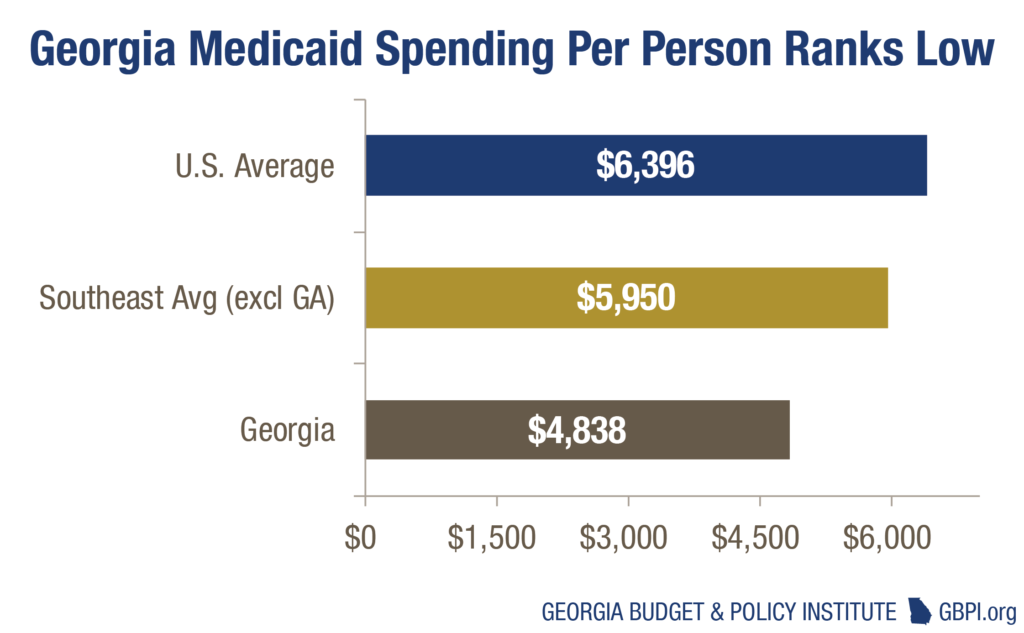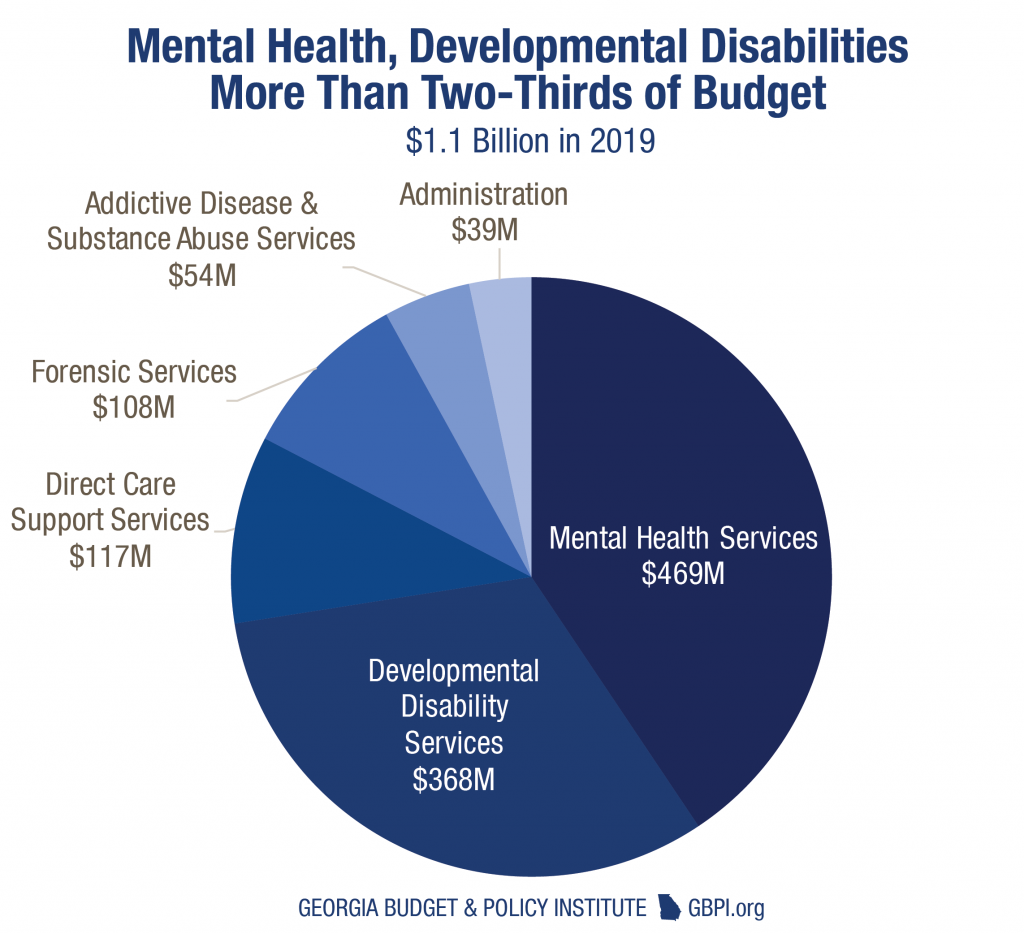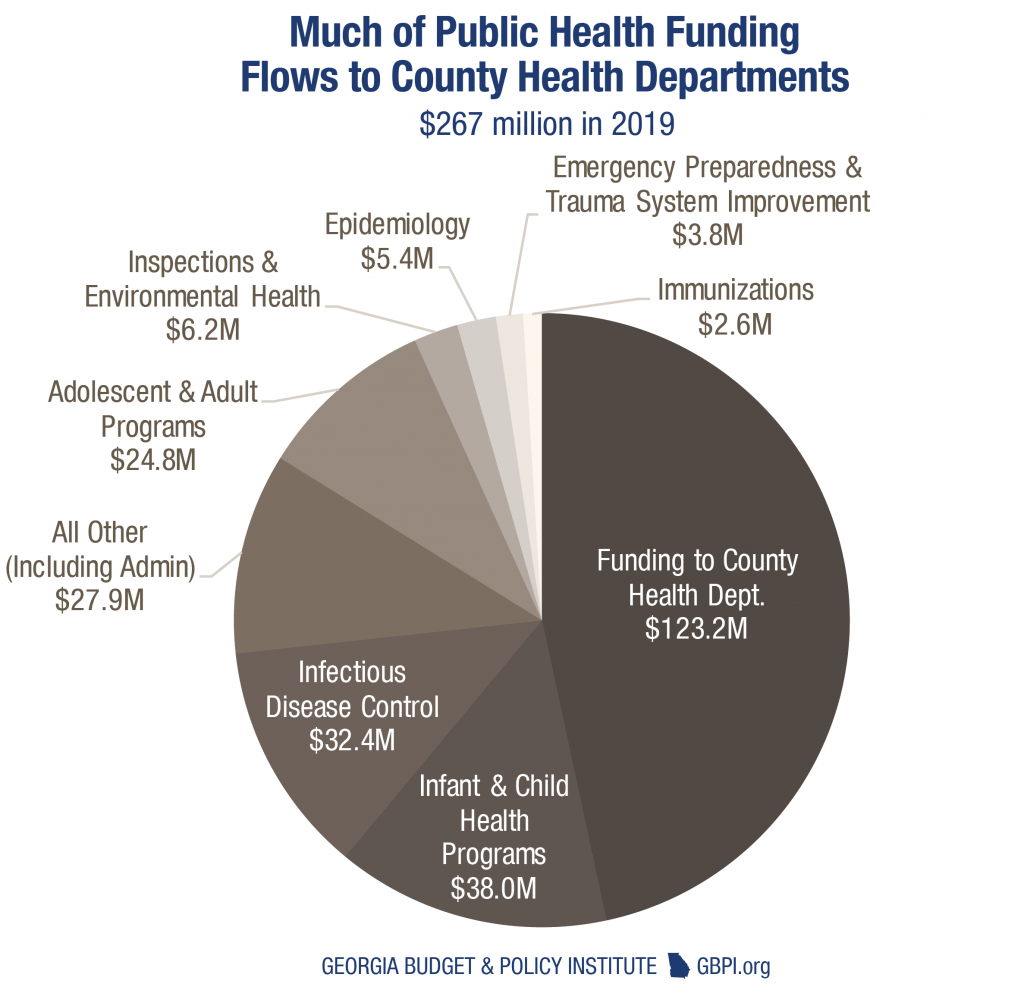Georgia Health Care Budget Overview
Health care services are primarily delivered through three state agencies, the departments of Community Health, Public Health, and Behavioral Health and Developmental Disabilities. State funding for these three agencies totals $4.8 billion in 2019, which is about 19 percent of state general spending. General Fund appropriations for these agencies account for $4.2 billion, or about 87 percent, while other sources total about $633 million. Money from the General Fund for these three agencies grew by $305 million from 2018 to 2019.
The Department of Community Health is the largest of Georgia’s three health care agencies. It accounts for $3.4 billion, or 70 percent of total state spending on health care. It operates Georgia’s Medicaid and PeachCare programs, some planning and regulatory functions, and the State Health Benefit Plan that provides health care to state employees and teachers. Funding for the state health plan comes from school districts, state agencies and their employees and retirees and is not counted in the state spending figure above.
Georgia plans to spend about $1.1 billion on behavioral health and developmental disabilities, which includes mental health and substance abuse services and assistance for people living with disabilities. This is about 24 percent of Georgia’s 2019 health care expense.
The Department of Public Health operates a variety of population-based health programs such as immunizations, health screenings and infectious disease control. It receives $282 million, or about 6 percent of Georgia’s health spending.

Medicaid and PeachCare Enrollment and Spending
Medicaid and PeachCare are expected to serve more than 2 million Georgians in 2019. The programs are important sources of health coverage for children, pregnant women, low-income seniors and people with physical and developmental disabilities. Medicaid and PeachCare cover nearly half of all children in Georgia. More than 1.3 million children, two-thirds of total state enrollees, are covered through the two programs. Medicaid also pays for more than half of all births in Georgia.
Medicaid is the main source of coverage for Georgians with long-term care needs, both in nursing homes and in community-based settings. Medicaid is the primary payer for three-fourths of nursing home patients in Georgia. Medicaid also helps pay Medicare premiums for more than 170,000 older Georgians.
Low-Income Medicaid serves children, pregnant women and some parents with very low incomes. The Aged, Blind & Disabled portion of the program serves the elderly and people with a qualifying disability. Most enrollees qualify through the low-income Medicaid program, but the majority of spending is for elderly and disabled patients. PeachCare is a separate program that serves children from families with income above the Medicaid threshold but often lack access to employer-sponsored coverage. PeachCare is entirely funded by the federal Children’s Health Insurance Program.

Georgia’s Medicaid Investment Ranks Near Bottom
Georgia expects to spend $3.1 billion in state funds to serve nearly 2 million people covered by Medicaid and PeachCare, a modest amount by national standards. Georgia’s spending per Medicaid enrollee ranked fifth lowest among the states, coming in at 32 percent below the national average in 2014, the most recent year available. Georgia ranked last in Medicaid spending per low-income resident in 2015.
Georgia’s low rank by both measures belies the harsh health and economic realities faced by much of its population. Georgia’s population consistently scores poorly in national health assessments, suggesting higher per-enrollee spending than most states is needed. Georgia had a poverty rate of 16 percent and ranked 10th worst for poverty among states in 2016. The uninsured rate in Georgia is the fifth-highest in the country. This suggests that higher per-capita spending is appropriate to pay for a large population of Medicaid-eligible residents.
A greater investment in Medicaid can allow the state to expand health services and increase the rates of reimbursement for health care providers. The 2019 budget adds nearly $17 million in new state funds to boost reimbursement rates for nursing home providers, but bringing Georgia’s investment closer to the national average will require more widespread funding increases.

Georgia Lawmakers Can Extend Health Coverage to Hundreds of Thousands of Uninsured Georgians
The health insurance marketplace created by the Affordable Care Act enrolled about 480,000 Georgians in 2018. These health coverage gains helped Georgia’s uninsured rate among employed people to fall 22 percent from 2013 to 2015. Nearly 9 in 10 Georgians who enrolled through the marketplace receive tax credits that reduce the cost of their health insurance premiums.
However, many Georgians still remain uninsured and are not able to get health care services when they need them. Georgia has the fifth highest uninsured rate at 13 percent, with more than 1.2 million uninsured residents. Georgia can significantly reduce the number of uninsured by joining the 34 states that expanded Medicaid eligibility, including Arkansas, Louisiana and Virginia. The new eligibility would provide coverage for people with incomes less than $16,750 for an individual and $28,675 for a family of three. More than 460,000 Georgians stand to gain a health insurance card if state lawmakers approve Medicaid expansion in 2019.
Expanding Medicaid eligibility leverages about $3 billion in federal funds that Georgia can use to pay for health services and help shore up the state’s struggling rural health system. That expansion requires an estimated $246 million in annual state matching funds over the next few years before accounting for resulting cost savings. Much of that new spending will likely be offset by increased economic activity in health-related commerce and decreased spending on health care for the uninsured.
 Behavioral Health and Developmental Disabilities
Behavioral Health and Developmental Disabilities
The Department of Behavioral Health and Developmental Disabilities operates a variety of programs that serve Georgians with mental health needs, addiction and developmental disabilities. The department also operates programs for forensic evaluation and treatment for Georgians under court jurisdiction. The department is budgeted to receive more than $1.1 billion in 2019 from the General Fund along with $10.3 million in Tobacco Funds, a total increase of $59.7 million compared to 2018.
Georgia entered into a legal settlement in 2010 with the U.S. Department of Justice that laid out a plan for the state to increase its mental health and developmental disability services in home or community settings relative to institutions.

Behavioral Health Funding Increases as Mental Illnesses and Substance Abuse Disorders Grow
In the past few years drug overdoses and suicide deaths increased rapidly in Georgia. Drug overdose deaths increased by 35 percent from 2012 to 2016 and suicides increased 25 percent in that time. This accelerating crisis calls for an increase in funding for mental health and substance abuse treatment and prevention.
Georgia’s 2019 budget adds $20.5 million for the department to implement recommendations of the Commission on Children’s Mental Health. That includes $10.4 million to pay for services for children and adolescents in mental health crisis, $4.3 million to extend mental health services to 100 more schools through the Georgia APEX Program, and $1.1 million for suicide prevention programs.
Georgia’s 2019 budget also adds money for mental health crisis services, including $6 million for a new behavioral crisis center and $5.9 million for crisis services for children under 12 who are diagnosed with autism. The budget allots $5 million for community-based services for people with mental illness and $4 million for substance abuse recovery programs. This is a good start to increase the availability of services and support. But the state support is still relatively low in some areas, such as substance abuse prevention programs. A sustained investment is needed to respond to Georgia’s need for more behavioral health treatment.
$20.5 million Added for Children’s Health Recommendations
| Purpose of Recommendation | Amount |
| One-time and ongoing funds for crisis respite services | $10,400,198 |
| School-based Georgia Apex Program for 13 additional grants | $4,290,000 |
| Plan and implement supported employment and education assistance for 500 more young adults at the rate of $6,120 per year, effective Jan. 1, 2019 | $1,530,000 |
| Suicide prevention | $1,092,000 |
| Opioid abuse prevention for youth | $790,801 |
| High fidelity wraparound services training | $610,545 |
| One-time and ongoing funds for telemedicine services | $382,500 |
| Develop a mobile application in coordination with the Georgia Crisis & Access hotline | $1,416,611 |
| Total general funds for commission recommendations |
$20,512,655 |
Public Health
The Department of Public Health operates a variety of programs focused on health promotion, disease prevention and health-related disaster response and preparedness. The department is budgeted to receive $267 million from the General Fund and $13.7 million in Tobacco Settlement money in 2019. The trauma care network commission receives $16.7 million from the General Fund in 2019. The largest state-funded programs provide financial assistance to county health departments, aim to prevent the spread of infectious disease and provide treatment and health promotion services aimed at children and infants. The department’s 2019 budget represents a $7 million increase compared to 2018.
Georgia’s public health programs also receive significant federal support. Federal money accounts for 58 percent of the department’s $688 million budget in 2019, while state funding accounts for the rest. The federally funded Special Supplemental Nutrition Program for Women, Infants and Children, also known as WIC, makes up the bulk of the federal funds and more than a third of the department’s total budget for 2019.

Continue Reading the 2019 Georgia Budget Primer
Intro
State Budget
K-12 Education
Higher Education
Human Services









